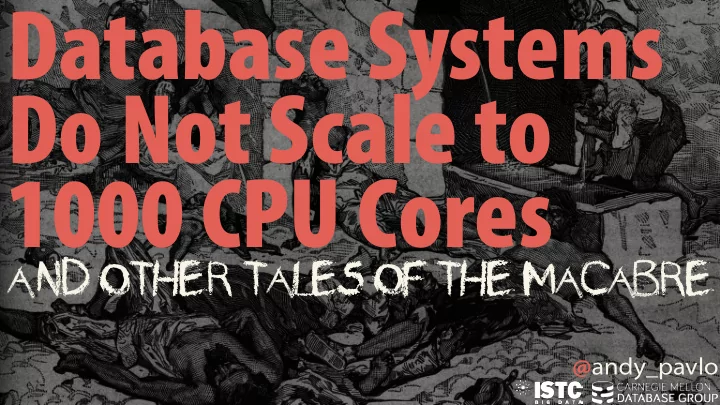

Database Systems Do Not Scale to 1000 CPU Cores And Other Tales of the Macabre @ andy_pavlo
2 Three million children die per year due to poor nutrition. Source: http://www.wfp.org/hunger/stats
3 Three days after you die, stomach enzymes start to digest you. Source: http://discovermagazine.com/2006/sep/10-20thingsdeath
4 Everyone in this room will be dead in 65 years. Source: http://discovermagazine.com/2006/sep/10-20thingsdeath
5 Database systems cannot scale to 1000 CPU cores. Source: http://www.vldb.org/pvldb/vol8/p209-yu.pdf
6 YCSB // DBx1000 on Graphite Simulator Write-Intensive Workload High Contention
7 Why This Matters • The era of single-core CPU speed-up is over. • Database applications are getting more complex and larger. • Existing DBMSs are unable to take advantage of future “many-core” CPU architectures.
8 Today’s Talk • Transaction Processing • Experimental Platform • Evaluation & Discussion • The (Dire) Future
9 Transaction Processing
10 On-line Transaction Processing • Fast operations that ingest new data and then update state using ACID transactions. • Transaction Example: – Send $50 from user A to user B
11 Concurrency Control • Allows transactions to access a database in a multi-programmed fashion while preserving the illusion that each of them is executing alone on a dedicated system. • Provides A tomicity + I solation in ACID
12 Concurrency Control • Two-Phase Locking (Pessimistic) • Timestamp Ordering (Optimistic)
13 Two-Phase Locking (2PL) Transaction #1 COMMIT BEGIN LOCK(A) LOCK(A) READ(A) LOCK(B) LOCK(B) WRITE(B) UNLOCK(A) UNLOCK(B) Growing Phase Shrinking Phase
14 Two-Phase Locking (2PL) Transaction #1 COMMIT BEGIN LOCK(A) LOCK(A) READ(A) LOCK(B) LOCK(B) WRITE(B) UNLOCK(A) UNLOCK(B) Transaction #2 COMMIT BEGIN LOCK(B) WRITE(B) LOCK(A) WRITE(A) UNLOCK(A) UNLOCK(B)
15 Two-Phase Locking (2PL) Transaction #1 COMMIT BEGIN LOCK(A) LOCK(A) READ(A) LOCK(B) LOCK(B) WRITE(B) UNLOCK(A) UNLOCK(B) Transaction #2 COMMIT BEGIN LOCK(B) WRITE(B) LOCK(A) WRITE(A) UNLOCK(A) UNLOCK(B)
16 Two-Phase Locking (2PL) • Deadlock Detection ( DEADLOCK ) • Non-waiting Deadlock Prevention ( NO_WAIT ) • Wait-and-Die Deadlock Prevention ( WAIT_DIE )
17 Timestamp Ordering (T/O) 10001 Transaction #1 COMMIT BEGIN • • • • • • • READ(A) WRITE(B) WRITE(A) Read Write Record Timestamp Timestamp A 10000 10000 B 10000 10000
18 Timestamp Ordering (T/O) 10001 Transaction #1 COMMIT BEGIN • • • • • • • READ(A) WRITE(B) WRITE(A) Read Write Record Timestamp Timestamp A 10001 10000 B 10000 10001
19 Timestamp Ordering (T/O) 10001 Transaction #1 COMMIT BEGIN • • • • • • • READ(A) WRITE(B) WRITE(A) Read Write Record Timestamp Timestamp A 10001 10005 B 10000 10001
20 Timestamp Ordering (T/O) • Basic T/O ( TIMESTAMP ) • Multi-Version Concurrency Control ( MVCC ) • Optimistic Concurrency Control ( OCC )
21 Concurrency Control Schemes DL_DETECT 2PL w/ Deadlock Detection NO_WAIT 2PL w/ Non-waiting Prevention WAIT_DIE 2PL w/ Wait-and-Die Prevention TIMESTAMP Basic T/O Algorithm MVCC Multi-Version T/O OCC Optimistic Concurrency Control
22 Evaluation Testbed
23 No DBMS supports No CPU supports multiple CC schemes. 1000 cores.
24 Experimental Platform L2 Core L1 Worker Threads DBx1000 Graphite Compute Simulator Cluster
25 Target Workload • Yahoo! Cloud Serving Benchmark (YCSB) – 20 million tuples – Each tuple is 1KB (total database is ~20GB) • Each transactions reads/modifies 16 tuples. • Varying skew in transaction access patterns. • Serializable isolation level.
26 Evaluation
27 YCSB // DBx1000 on Graphite Simulator Read-Only Workload No Contention
28 YCSB // DBx1000 on Graphite Simulator Write-Intensive Workload Medium Contention
29 YCSB // DBx1000 on Graphite Simulator Write-Intensive Workload High Contention
30 YCSB // DBx1000 on Graphite Simulator Write-Intensive Workload High Contention Time % Breakdown (512 Cores)
31 Bottlenecks • Lock Thrashing – DL_DETECT, WAIT_DIE • Timestamp Allocation – All T/O algorithms + WAIT_DIE • Memory Allocations – OCC + MVCC
32 Bottlenecks • Lock Thrashing – DL_DETECT, WAIT_DIE • Timestamp Allocation – All T/O algorithms + WAIT_DIE • Memory Allocations – OCC + MVCC
33 Locking Thrashing • Each transaction waits longer to acquire locks, causing other transactions to wait a longer to acquire locks. • The perfect workload is where transactions acquire locks in primary key order.
34 YCSB // DBx1000 with 2PL DL_DETECT Write-Intensive Workload No Deadlocks (Ordered Lock Acquisition)
35 YCSB // DBx1000 with 2PL DL_DETECT Write-Intensive Workload No Deadlocks (Ordered Lock Acquisition)
36 Potential Solutions
37 Hardware/Software Co-Design • Bottlenecks can only be overcome through new hardware-level optimizations: – Hardware-accelerated Lock Sharing – Asynchronous Memory Copying – Decentralized Memory Controller.
38 Next Steps • Evaluating other main bottlenecks in DBMSs: – Logging + Recovery – Indexes • Extend DBx1000 to support distributed concurrency control algorithms.
39 Xiangyao Andy Mike Srini Yu Pavlo Stonebraker Devadas http://cmudb.io/1000cores
END @andy_pavlo
Recommend
More recommend